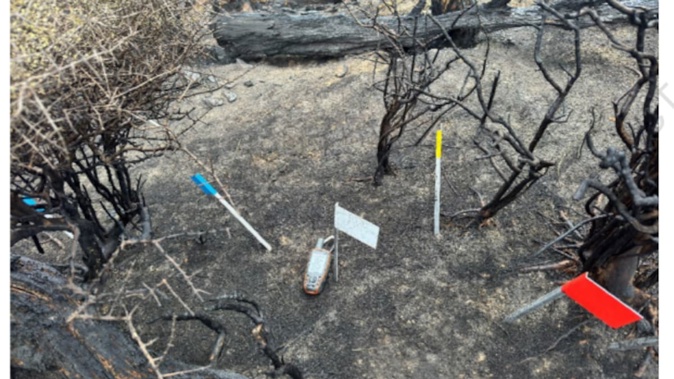
A fire that destroyed nearly 600ha of native bush in Canterbury’s Craigieburn Forest Park was deliberately lit by youths on a school camp using a spark-producing fire starter and a flammable aerosol spray, and cost almost $2 million to extinguish.
The blaze, on a hillside on Department of Conservation land near Bridge Hill, was first reported by a passing motorist at 4.24am on December 5, 2024.
The first crew arrived at the scene by 5.08am.

An aerial view of the fire field at Canterbury’s Craigieburn Forest Park after a blaze in December 2024. Photo / Fire and Emergency NZ
The fire ground was deemed inactive by December 14 but the incident was not closed officially until December 23.
An investigation report released to the Herald by Fire and Emergency New Zealand today said a total of 596.5ha was burned and suppression efforts, including ground crews, helicopters and specialist equipment, cost $1,917,429.48, including GST.
Fire and Emergency specialist fire investigator Jason Hobbs described it in his report as an “extremely fast-moving fire” that spread rapidly, fuelled by a variety of material.
It was lit about 80m off a walking track using a “ferrocerium rod and an aerosol accelerant”.
A ferrocerium rod, often called a ferro rod or fire starter, is a small survival tool used to create sparks and start fires.
They are commonly used by campers, hikers and trampers as they are a reliable fire-starting tool that works even in wet conditions.
Hobbs said “witnesses” directed him to the area where the fire was lit, marking the approximate location on a map.
He and a team of investigators then carried out a scene examination, starting with a “retracing” of the steps of the “witnesses” to where they said the fire was started.

Images published in the fire investigation report show where the blaze was started by youths who were on a school camp. Photo / Fire and Emergency NZ
Hobbs’ report included images of the point where the youths started the blaze.
“The exact point of origin was unable to be determined but was between two shrubs and behind a fallen log somewhere in the ignition area,” he said.
“The ignition area was determined to be approximately 80m southeast from the walking track. The ignition source was not located in the ignition area, as it had been removed.
“The first fuel ignited was dead, dry grass obtained from the area. The dry grass was ignited using a ferrocerium rod and striker with the assistance of an aerosol acceleration.
“Fuel conditions on the night made ignition of the grass difficult using sparks from a ferrocerium rod alone. A small vegetation fire was constructed from available dead twigs and sticks fed on to the grass.”
Hobbs said the dramatic shift in weather overnight created perfect conditions for a fast-moving wildfire.
“The terrain was steep with fine fuels, dry conditions and a westerly wind. The fire spread rapidly across the hillside,” he said in the report.
“Fuels included grasses, tussocks, scrub, wilding pines – live, dead and litter, mountain beech and manuka. There was a significant fuel build-up.
“Light rain occurred the night before… conditions initially made ignition difficult. However, by 4am on December 5, a westerly wind and drop in humidity dried fuels rapidly [and the] fire spread west to east, following terrain and ridge lines.
“Conditions caused extreme fire behaviour with crown fires, long-distance spotting, and fire whirlwinds.”
Hobbs confirmed the fire burned a total of 596.5ha.
“The origin area showed evidence of an ignition source and accelerant, with no other viable ignition sources such as lightning, powerlines, or smoking detected,” he said.
Several school camps were evacuated after the fire. Police later spoke to students at four schools to ascertain if they had any part in causing the blaze.
In February, three students were referred to Youth Aid in relation to the incident.
It was reported the youths went for a walk in the night and lit a fire, then tried to put it out, at one stage urinating on it.
Anna Leask is a senior journalist who covers national crime and justice. She joined the Herald in 2008 and has worked as a journalist for 19 years with a particular focus on family and gender-based violence, child abuse, sexual violence, homicides, mental health and youth crime. She writes, hosts and produces the award-winning podcast A Moment In Crime, released monthly on nzherald.co.nz.
Take your Radio, Podcasts and Music with you









